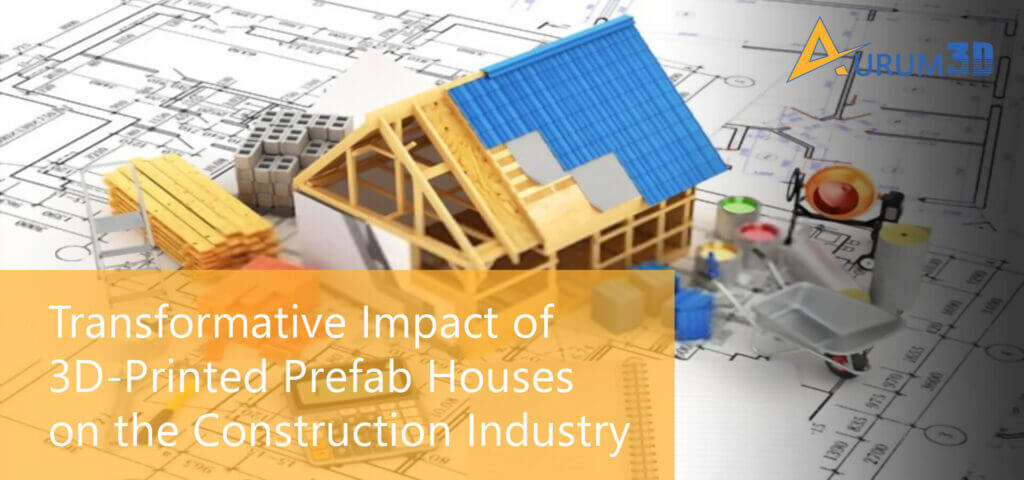The increase in the prices of building materials has been escalating the construction cost of residential houses consistently. The escalating construction cost makes it difficult for many people to build houses using traditional construction methods. Many property owners these days leverage prefab construction as a new-age alternative to traditional constructions to live in their own houses without incurring huge expenses. Lets understand the transformative impact of 3D-Printed prefab houses on the construction industry.
According to Wikipedia,
“Prefabricated homes, often referred to as prefab homes or simply prefabs, are specialist dwelling types of prefabricated building, which are manufactured off-site in advance, usually in standard sections that can be easily shipped and assembled. Some current prefab home designs include architectural details inspired by postmodernism or futurist architecture.”
Why Homeowners Prefer Prefab Construction to Traditional Constructions?
According to an industry report released by Mordor Intelligence,
“The Prefabricated Building Market in India is expected to grow at a CAGR of approximately 8.5% from 2021 to 2026. The next decade belongs to prefabrication with the Indian construction sector expected to expand to a size of USD 1 trillion and contribute over 15% to the overall GDP.”
The forecast report suggests a consistent increase in the number of homeowners switching from traditional construction to prefab construction. A large percentage of homeowners will opt for prefab houses to curtail constructions time and cost. But homeowners can leverage a slew of benefits by preferring prefab construction to traditional constructions.
Construction Speed:
Often development and improvement of construction time increase traditional construction time. Likewise, the construction of traditional houses is delayed due to weather events like heavy rain and extreme heat. But construction of prefab houses is not affected by construction site development and weather-related delays.
Durability:
Most builders these days use high-quality materials to make prefab houses more durable and energy-efficient. They test the durability of modules elaborately to eliminate chances of cracks and fractures during transportation and mounting processes. Hence, prefab homes are as sturdy and durable as constructed houses.
Customizability:
The homeowners have to incur additional expenses to build customized houses using traditional construction methods. But they can customize the prefab houses according to their precise needs and preferences. Many companies these days deliver custom-built prefab houses according to the precise needs of every client.
Maintenance:
Materials used in traditional construction are prone to damage caused by mold, mildew, rust, and similar nasty environmental toxins. Homeowners have to incur recurring maintenance expenses to retain the look and feel of their homes. But 3D-Printed prefab houses these days are built with energy-efficient and healthy materials. Hence, they do not require expensive maintenance to beat nasty environmental toxins.
Disaster Recovery:
A homeowner cannot repair and restore a traditional house without incurring huge expenses after natural disasters. The builders need adequate time to repair houses damaged due to natural disasters. But the 3D-Printed Prefab Houses can be repaired and renovated in a short amount of time after natural disasters. Also, most prefab houses these days are constructed using materials that can withstand elements.
Cost:
The prefab homes are less expensive than traditional houses. Many homeowners these days opt for prefab houses to save money. Likewise, many companies these days send quotes to customers that include the cost of prefab homes along with delivery and crane fees. A homeowner can further curtail the cost of prefab homes by comparing quotes received from various companies.
Remote Location:
While constructing traditional houses in remote locations, homeowners need to incur huge and recurring costs to transport materials and equipment. The homeowners can easily curtail transportation costs by opting for prefab homes regardless of the location.
How does 3D Printing Technologies Reduce Prefab Construction Time and Cost?
Many homeowners prefer prefab houses to traditional houses to save money. 3D printing is one of the disruptive technologies that contribute immensely towards making prefab construction popular and affordable. Many 3D printing service providers help architects and builders to curtail prefab construction and time in a number of ways.
Many Construction 3D Printers
Construction 3D printers develop various components of prefab houses by depositing earth materials layer by layer. They produce models or components using paste-type components like concrete. Leading companies these days use different construction 3D printers to produce prefab houses of varying build sizes.
Simultaneous Components Printing
A construction 3D printer can produce multiple components or models of prefab houses simultaneously. Hence, a company can deliver prefabricated houses in a few months. Many 3D printing companies these days deliver custom-made prefab houses in about six months.
Customization and Personalization
The construction 3D printers produce prefab houses based on 3D models created using CAD software. A 3D engineer can modify and customize the prefab house simply by making relevant changes to the 3D models. Hence, most companies these days leverage custom 3D printing services to customize prefab houses according to the precise needs of every client.
Eco-Friendly and Energy-Efficient Homes
Construction 3D printers enable engineers to experiment with a variety of paste-type filaments. Many companies these days make prefab houses energy-efficient and eco-friendly using organic filaments. They further finetune the 3D models to make the prefab house use solar energy and emit lower carbon dioxide regularly.
Reduce Construction Waste
The advanced constructor 3D printers reduce prefab construction time and costs significantly. Also, they contribute hugely towards protecting the environment by reducing constriction waste by30%. The company can further reduce overall construction costs by reusing or recycling the filament in the future.
Innovation and R&D
The construction 3D printing technologies have been improving consistently. Both companies and startups have been experimenting with the latest construction 3D printing technologies to build pedestrian bridges and print houses in the space. The innovation will contribute hugely towards making prefab homes popular and affordable in the future.
Aurum3D is one of the 3D printing companies in Bangalore that have been facilitating and popularizing prefab construction in India. In a short amount of time, the Bangalore-based 3D printing company has successfully delivered 3D-printed prefab houses based on 3D models shared by architects. The 3D artists and engineers at Aurum3D help architectures to convert their ideas into prefab houses by overcoming constraints related to skills and resources.

